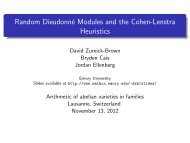alternative lecture notes - Rational points and algebraic cycles
alternative lecture notes - Rational points and algebraic cycles
alternative lecture notes - Rational points and algebraic cycles
Create successful ePaper yourself
Turn your PDF publications into a flip-book with our unique Google optimized e-Paper software.
Loosely speaking, given functors L: A → B <strong>and</strong> R: B → A, they are called adjoint<br />
functors if there is a bijection Hom B (L(a), b) = Hom A (a, R(b)) varying functorially in a ∈ A<br />
<strong>and</strong> b ∈ B.<br />
Definition 3.1. A pair of functors L: A → B <strong>and</strong> R: B → A together with two natural<br />
transformations u: id A → R ◦ L (called the unit) <strong>and</strong> c: L ◦ R → id B (called the co-unit) is<br />
called an adjunction if for every a ∈ A the composition<br />
is id L(a) , <strong>and</strong> for every b ∈ B the composition<br />
is id R(b) .<br />
<strong>and</strong><br />
Given an adjunction as above, we get<br />
L(a) L◦u<br />
−→ LRL(a) c◦L<br />
−→ L(a)<br />
R(b) u◦R<br />
−→ RLR(b) R◦c<br />
−→ R(b)<br />
Hom(L(a), b) → Hom(RL(a), R(b) u → Hom(a, R(b))<br />
Hom(L(a), b) c ← Hom(L(a), LR(b)) ← Hom(a, R(b)).<br />
Example 3.2. Let U be the functor Sets ← Groups forgetting the group structure. (Do<br />
not confuse U with the unit.) Let Fr: Sets → Groups be the functor sending a set to the<br />
free group on the set. Then<br />
<strong>and</strong> in fact we get an adjunction.<br />
Hom Groups (Fr(S), G) = Hom Sets (S, U(G)),<br />
Example 3.3. Let R be commutative ring. Let A be an R-module. Then ⊗A: R-modules →<br />
R-modules <strong>and</strong> Hom(A, −) in the other direction are adjoint functors: in particular,<br />
Hom(B ⊗ A, C) = Hom(B, Hom(A, C)).<br />
Example 3.4. Let R → S be a ring homomorphism. Then ⊗ R S : R-modules → S-modules<br />
is left adjoint to the functor U in the opposite direction that maps an S-module to the<br />
R-module obtained by composing the action with R → S.<br />
Let D be a small category. Let const: C → C D be the functor taking an object to the<br />
constant diagram. A limit functor is a functor lim: C D → C that is right adjoint to const.<br />
←−<br />
Notation: Write L ⊣ R if (L, R) are a pair of adjoint functors. Thus const ⊣ lim. Similarly<br />
←−<br />
lim<br />
−→ ⊣ const.<br />
A limit functor does not always exist. In fact, individual limits need not exist. For<br />
example: let D be the 3-object category with two morphisms to the same object. If C is the<br />
same category, the identity functor D → C does not have a limit.<br />
Call C complete if all limits of diagrams D → C exist, for every small category D. A<br />
functor R: C → D is called continuous if it respects limits. There is always a morphism<br />
R ( lim F ) → lim R◦F , from the universal property of the latter. To say that R is continuous<br />
←− ←−<br />
means that this morphism is always an isomorphism.<br />
Theorem 3.5. If R has a left adjoint, then R is continuous.<br />
6



